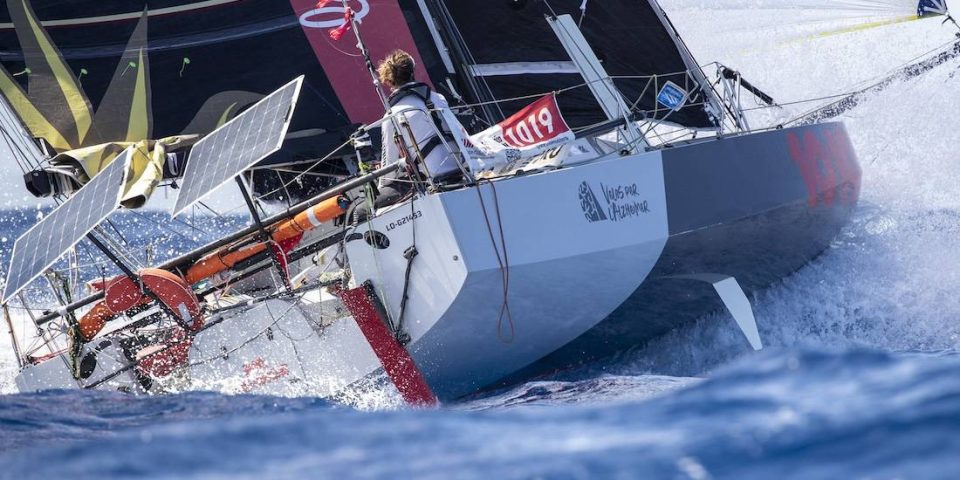Marked by speed records, a low number of retirements and an international podium, the 24th edition of the La Boulangère Mini Transat was won in the proto class by Federico Waksman and in the series by Luca Rosetti. Tip & Shaft reviews the race with organiser Emmanuel Versace, weather consultant Christian Dumard, coaches Damien Cloarec (Roscoff) and François Jambou (Concarneau) and architect David Raison.
The 24th edition of the Mini Transat came to an end on Friday morning with the arrival of the last competitor, Romain Van Enis (James Caird), in Saint-François, Guadeloupe. Of the 90 competitors who lined up at the start on 25 September in Les Sables d’Olonne, “there were only four retirements, which is less than 5% of the fleet, which proves that the boats are well prepared”, emphasises Emmanuel Versace. François Jambou, coach to around fifteen minis in Concarneau, makes the same observation: “The projects are getting more and more serious. In order to qualify, the ministes are sailing more and the general level is increasing”.
Another major feature of this year’s edition is the supremacy of foreign sailors on the podium. In the proto class, overall victory (and victory on the second leg) went to Uruguayan Federico Waksman (Repremar Shipping Uruguay) ahead of Spaniard Carlos Manera (Xucla), the latter having won the first leg. In the series, Italy’s Luca Rosetti (race = care) won on his Maxi 650, while Belgium’s Michaël Gendebien (Barillec Marine-Actemium) won the first leg on a Pogo 3 (finishing just off the podium overall). “It’s great news, as it will raise the profile of the class internationally,” says a delighted François Jambou.
Pogo remain in the match
The transatlantic race did not result in a clear domination of the Maxi 650s in the series, as some had expected. “On the contrary, we took a beating on the first leg, with three Pogo 3s on the podium [Michaël Gendebien, Titouan Quiviger and Bruno Lemunier, editor’s note]“, reacts the Maxi’s architect, David Raison. There were several reasons for this: “First of all, there were few conditions to favour the speed of the Maxis,” explains Christian Dumard. “Then, along the coast of Portugal, we had to shift to the west, which is what a lot of the Pogo boats did.” Conversely, “few of the Maxis were positioned on the right side of the race zone”, adds David Raison
In the end, although Luca Rosetti’s Maxi 650 won, the podium was completed by two Pogo 3s, Bruno Lemunier’s and Grégoire Hue’s, while in the proto class, David Raison’s title-winning won again, ahead of a Manuard design and another Raison design, Frérots Branchet(Julien Letissier
The second leg saw a fine strategic battle, with three distinct options emerging: one very far north, a second to the south and a third in between. In the series, “in the end, it was the northerly option that came out on top with the victory of Luca Rosetti, who sailed a perfect course and set a crazy pace”, praised Damien Cloarec, trainer of around fifteen minis in Roscoff. “He was very consistent, and I had the impression that the boat and skipper were working well together, with few mistakes and few extra miles,” adds David Raison.
The 24-hour race record
beaten by a production Mini
In the proto category, it was an intermediate route that enabled Federico Waksman to win, more than 8hr 30mn ahead of Carlos Manera. “Although he missed the first stage slightly, Federico drove a very clean trajectory on the second,” emphasised David Raison. And Emmanuel Versace added: “I think he had the knife between his teeth, very sure of his strengths, on Pierre Le Roy’s old boat (winner in 2021), which he managed to tame.” François Jambou, who saw the Uruguayan train in Concarneau, confirms his tenacious temperament: “He doesn’t give up! I think he was prepared to take a lot of risks to win; that was really his goal.”
The southerly option also enabled Hugues De Prémare, on a production Maxi 650, to beat the absolute 24-hour Mini record, held until now by Pierre Le Roy’s proto, by covering 317.25 miles in 24 hours (average speed 13.22 knots). “He went very far south to get some pressure and then set a course with as few gybes as possible,” explains David Raison. “He clearly wanted to go for this record, as he told me before the start. I wasn’t too surprised that he beat the series record, as these boats are now more reliable, but to beat the proto record is very, very strong. It must have been particularly hard and challenging.”
Foilers? Not yet the ultimate weapon
How did the two foilers in the fleet fare? “We were really looking forward to seeing how Carlos’s Manuard foiling design would perform offshore. It’s going well, but it’s not a revolution. As for Caroline Boule (Nicomatic, 16th overall), we’ve seen in training that she can blow everyone away in bay races, on flat seas and in medium conditions. But here, in seas, her performances are very smoothed out.” Christian Dumard added: “The conditions weren’t right for her to get the best out of her boat, there weren’t enough steady winds.”
The performance of Jacques Delcroix (Actual), 6th overall on his 2009 Bertrand design, also proved “that it’s still possible to have high-performance sporting projects without having the latest boat“, enthused François Jambou. “Jacques really sails to perfection,” points out Damien Cloarec. “If you put the 1019 [Federico Waksman’s Raison design] in his hands, he has what it takes to win the transatlantic race.”
Our experts also highlight the good performances in the series by Grégoire Hue (SPC), 3rd overall on his Pogo 3, and in the proto class by Slovenian Uroš Krasevac (Ashika II), 5th, Thaïs Le Cam (Frérots TPM), 9th, as well as Julien Letissier (Frérots Branchet), 3rd, and Marie Gendron (Léa Nature), 4th, who put up an intense fight.
Photo: Vincent Olivaud / La Boulangère Mini Transat






